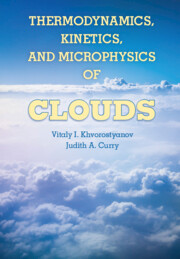Book contents
- Frontmatter
- Contents
- Preface
- 1 Introduction
- 2 Clouds and Their Properties
- 3 Thermodynamic Relations
- 4 Properties of Water and Aqueous Solutions
- 5 Diffusion and Coagulation Growth of Drops and Crystals
- 6 Wet Aerosol Processes
- 7 Activation of Cloud Condensation Nuclei into Cloud Drops
- 8 Homogeneous Nucleation
- 9 Heterogeneous Nucleation of Drops and Ice Crystals
- 10 Parameterizations of Heterogeneous Ice Nucleation
- 11. Deliquescence and Efflorescence in Atmospheric Aerosols
- 12 Terminal Velocities of Drops and Crystals
- 13 Broad Size Spectra in Clouds and the Theory of Stochastic Condensation
- 14 Analytical Solutions to the Stochastic Kinetic Equation for Precipitating Clouds
- References
- Notations
- Index
1 - Introduction
Published online by Cambridge University Press: 05 September 2014
- Frontmatter
- Contents
- Preface
- 1 Introduction
- 2 Clouds and Their Properties
- 3 Thermodynamic Relations
- 4 Properties of Water and Aqueous Solutions
- 5 Diffusion and Coagulation Growth of Drops and Crystals
- 6 Wet Aerosol Processes
- 7 Activation of Cloud Condensation Nuclei into Cloud Drops
- 8 Homogeneous Nucleation
- 9 Heterogeneous Nucleation of Drops and Ice Crystals
- 10 Parameterizations of Heterogeneous Ice Nucleation
- 11. Deliquescence and Efflorescence in Atmospheric Aerosols
- 12 Terminal Velocities of Drops and Crystals
- 13 Broad Size Spectra in Clouds and the Theory of Stochastic Condensation
- 14 Analytical Solutions to the Stochastic Kinetic Equation for Precipitating Clouds
- References
- Notations
- Index
Summary
Relations among Thermodynamics, Kinetics, and Cloud Microphysics
The most distinctive feature of the Earth when viewed from space is the presence of clouds covering approximately 60% of its surface area. Clouds are a major factor in determining the Earth’s radiation budget, by reflecting shortwave radiation and emitting longwave radiation. Through their ability to precipitate, clouds provide virtually all of the fresh water on Earth. Clouds are associated with some of the most damaging weather in the world: torrential rains, severe winds and tornadoes, hail, thunder and lightning, and snowstorms. The latent heat released in clouds is an important source of energy for scales of motion ranging from the global atmospheric circulation, to hurricanes and mid-latitude cyclones, to individual storms. Clouds are also important in atmospheric chemistry because they play an active role in many chemical reactions and transport chemicals through updrafts and scavenging associated with precipitation.
A major challenge in understanding and modeling clouds is the broad range of spatial scales involved. The scales range from the micron scale of individual cloud drops, to the scale of an individual cloud (kilometers), up to the scale of the largest cloud systems (1000 km). Our present computational capability allows only a small range of spatial scales to be simulated explicitly in a single model; processes on the other scales are either specified or parameterized.
- Type
- Chapter
- Information
- Publisher: Cambridge University PressPrint publication year: 2014



